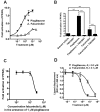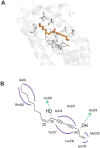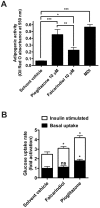Polyacetylenes from Notopterygium incisum--new selective partial agonists of peroxisome proliferator-activated receptor-gamma
- PMID: 23630612
- PMCID: PMC3632601
- DOI: 10.1371/journal.pone.0061755
Polyacetylenes from Notopterygium incisum--new selective partial agonists of peroxisome proliferator-activated receptor-gamma
Abstract
Peroxisome proliferator-activated receptor gamma (PPARγ) is a key regulator of glucose and lipid metabolism and therefore an important pharmacological target to combat metabolic diseases. Since the currently used full PPARγ agonists display serious side effects, identification of novel ligands, particularly partial agonists, is highly relevant. Searching for new active compounds, we investigated extracts of the underground parts of Notopterygium incisum, a medicinal plant used in traditional Chinese medicine, and observed significant PPARγ activation using a PPARγ-driven luciferase reporter model. Activity-guided fractionation of the dichloromethane extract led to the isolation of six polyacetylenes, which displayed properties of selective partial PPARγ agonists in the luciferase reporter model. Since PPARγ activation by this class of compounds has so far not been reported, we have chosen the prototypical polyacetylene falcarindiol for further investigation. The effect of falcarindiol (10 µM) in the luciferase reporter model was blocked upon co-treatment with the PPARγ antagonist T0070907 (1 µM). Falcarindiol bound to the purified human PPARγ receptor with a Ki of 3.07 µM. In silico docking studies suggested a binding mode within the ligand binding site, where hydrogen bonds to Cys285 and Glu295 are predicted to be formed in addition to extensive hydrophobic interactions. Furthermore, falcarindiol further induced 3T3-L1 preadipocyte differentiation and enhanced the insulin-induced glucose uptake in differentiated 3T3-L1 adipocytes confirming effectiveness in cell models with endogenous PPARγ expression. In conclusion, we identified falcarindiol-type polyacetylenes as a novel class of natural partial PPARγ agonists, having potential to be further explored as pharmaceutical leads or dietary supplements.
Conflict of interest statement
Figures




Similar articles
-
Polyyne hybrid compounds from Notopterygium incisum with peroxisome proliferator-activated receptor gamma agonistic effects.J Nat Prod. 2014 Nov 26;77(11):2513-21. doi: 10.1021/np500605v. Epub 2014 Oct 21. J Nat Prod. 2014. PMID: 25333853 Free PMC article.
-
Polyacetylenes from carrots (Daucus carota) improve glucose uptake in vitro in adipocytes and myotubes.Food Funct. 2015 Jul;6(7):2135-44. doi: 10.1039/c5fo00223k. Food Funct. 2015. PMID: 25970571
-
Falcarindiol Isolated from Notopterygium incisum Inhibits the Quorum Sensing of Pseudomonas aeruginosa.Molecules. 2021 Sep 29;26(19):5896. doi: 10.3390/molecules26195896. Molecules. 2021. PMID: 34641440 Free PMC article.
-
Aliphatic C(17)-polyacetylenes of the falcarinol type as potential health promoting compounds in food plants of the Apiaceae family.Recent Pat Food Nutr Agric. 2011 Jan;3(1):64-77. doi: 10.2174/2212798411103010064. Recent Pat Food Nutr Agric. 2011. PMID: 21114468 Review.
-
Natural product agonists of peroxisome proliferator-activated receptor gamma (PPARγ): a review.Biochem Pharmacol. 2014 Nov 1;92(1):73-89. doi: 10.1016/j.bcp.2014.07.018. Epub 2014 Jul 30. Biochem Pharmacol. 2014. PMID: 25083916 Free PMC article. Review.
Cited by
-
N6-methyladenosine methylation analysis of circRNAs in acquired middle ear cholesteatoma.Front Genet. 2024 Jun 24;15:1396720. doi: 10.3389/fgene.2024.1396720. eCollection 2024. Front Genet. 2024. PMID: 38978876 Free PMC article.
-
Polyyne hybrid compounds from Notopterygium incisum with peroxisome proliferator-activated receptor gamma agonistic effects.J Nat Prod. 2014 Nov 26;77(11):2513-21. doi: 10.1021/np500605v. Epub 2014 Oct 21. J Nat Prod. 2014. PMID: 25333853 Free PMC article.
-
Falcarindiol Purified From Carrots Leads to Elevated Levels of Lipid Droplets and Upregulation of Peroxisome Proliferator-Activated Receptor-γ Gene Expression in Cellular Models.Front Pharmacol. 2020 Aug 28;11:565524. doi: 10.3389/fphar.2020.565524. eCollection 2020. Front Pharmacol. 2020. PMID: 32982759 Free PMC article.
-
Targeting TGF-β1/miR-21 Pathway in Keratinocytes Reveals Protective Effects of Silymarin on Imiquimod-Induced Psoriasis Mouse Model.JID Innov. 2022 Dec 16;3(3):100175. doi: 10.1016/j.xjidi.2022.100175. eCollection 2023 May. JID Innov. 2022. PMID: 36968096 Free PMC article.
-
In vitro hair growth-promoting effects of araliadiol via the p38/PPAR-γ signaling pathway in human hair follicle stem cells and dermal papilla cells.Front Pharmacol. 2024 Dec 3;15:1482898. doi: 10.3389/fphar.2024.1482898. eCollection 2024. Front Pharmacol. 2024. PMID: 39691387 Free PMC article.
References
-
- Hansen MK, Connolly TM (2008) Nuclear receptors as drug targets in obesity, dyslipidemia and atherosclerosis. Current opinion in investigational drugs 9: 247–255. - PubMed
-
- Desvergne B, Michalik L, Wahli W (2006) Transcriptional regulation of metabolism. Physiological reviews 86: 465–514. - PubMed
-
- Evans RM, Barish GD, Wang YX (2004) PPARs and the complex journey to obesity. Nature medicine 10: 355–361. - PubMed
-
- Schoonjans K, Martin G, Staels B, Auwerx J (1997) Peroxisome proliferator-activated receptors, orphans with ligands and functions. Current opinion in lipidology 8: 159–166. - PubMed
Publication types
MeSH terms
Substances
LinkOut - more resources
Full Text Sources
Other Literature Sources

